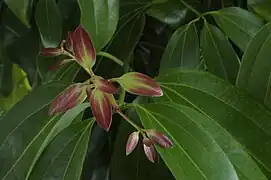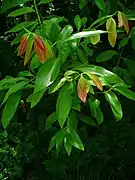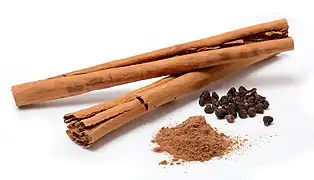| Cinnamomum verum | |
|---|---|
 | |
| Cinnamomum verum foliage and flowers | |
| Scientific classification | |
| Kingdom: | Plantae |
| Clade: | Tracheophytes |
| Clade: | Angiosperms |
| Clade: | Magnoliids |
| Order: | Laurales |
| Family: | Lauraceae |
| Genus: | Cinnamomum |
| Species: | C. verum |
| Binomial name | |
| Cinnamomum verum | |
| Synonyms | |
| |
Cinnamomum verum[2] (Cinnamomum zeylanicum,[3] also called true cinnamon tree or Ceylon cinnamon tree) is a small evergreen tree belonging to the family Lauraceae, native to Sri Lanka.[4] The inner bark of the tree is historically regarded as the 'spice' cinnamon,[3][5] though this term was later generalized for both C. cassia and C. zeylanicum as well.[3]
Description
Cinnamomum verum trees are 10–15 metres (30–50 feet) tall. The leaves are ovate-oblong in shape and 7–18 cm (3–7 inches) long. The flowers, which are arranged in panicles, have a greenish color and a distinct odor. The fruit is a purple 1 cm drupe containing a single seed.[6]
Cultivation
The old botanical synonym for the tree, Cinnamomum zeylanicum, is derived from Sri Lanka's former name, Ceylon.[7] Sri Lanka still produces 80–90%[8] of the world's supply of C. verum, which is also cultivated on a commercial scale in the Seychelles, Madagascar and Tanzania.[9][10]
On Borneo, Cinnamomum verum is cultivated at low elevations in Sarawak (Kuching District), Sabah (Keningau and Sandakan districts), and Kalimantan.[11]
Cultivars
There are several different cultivars of Cinnamomum verum based on the taste of bark:[12]
- Type 1 – Sinhala: Pani Kurundu (පැණි කුරුඳු), Pat Kurundu (පත් කුරුඳු), Mapat Kurundu (මාපත් කුරුඳු)
- Type 2 – Sinhala: Naga Kurundu (නාග කුරුඳු)
- Type 3 – Sinhala: Pani Miris Kurundu (පැණි මිරිස් කුරුඳු)
- Type 4 – Sinhala: Weli Kurundu (වැලි කුරුඳු)
- Type 5 – Sinhala: Sewala Kurundu (සෙවල කුරුඳු)
- Type 6 – Sinhala: Kahata Kurundu (කහට කුරුඳු)
- Type 7 – Sinhala: Peiris Kurundu (පීරිස් කුරුඳු)
Processing
The trees grow as leafy bushes, usually reaching a maximum of 3 m (10 ft) in height. They are first harvested at 3 years old and continue producing well for 40–50 years. Small side branches (1.5–5 cm in diameter) are removed from the trees. The outer bark is removed and processed into mulch. Twigs, leaves and berries (seeds) are crushed to make cinnamon oil, a less valuable byproduct. The inner bark of the branches is loosened by being rubbed with a brass rod. The bark is then split with a brass or stainless-steel knife and peeled off as intact as possible. Long, full 'quills' of cinnamon are more valuable than broken pieces. These quills are then dried over several days in the shade, then in darkness. All this work is done by hand by experienced workers; this is the most expensive part of producing cinnamon spice. Finally, the dried bark is cut into sticks or ground into powder for sale to consumers.
Grading
The Sri Lankan grading system divides the cinnamon quills into four groups:
- Alba, less than 6 mm (0.24 in) in diameter
- Continental, less than 16 mm (0.63 in) in diameter
- Mexican, less than 19 mm (0.75 in) in diameter
- Hamburg, less than 32 mm (1.3 in) in diameter
These groups are further divided into specific grades. For example, Mexican is divided into M00000 special, M000000 and M0000, depending on quill diameter and number of quills per kilogram. Any pieces of bark less than 106 mm (4.2 in) long are categorized as quillings. Featherings are the inner bark of twigs and twisted shoots. Chips are trimmings of quills, outer and inner bark that cannot be separated, or the bark of small twigs.
Medicinal uses
Cinnamon has a long history of use in traditional medicine as a digestive aid.[13]
Preliminary studies show that cinnamon could slow symptoms of Alzheimer's disease through the reduction of the oligomerization of beta-amyloid.[14]
Gallery
 Leaves of the Cinnamomum verum plant
Leaves of the Cinnamomum verum plant Leaves of the Cinnamomum verum plant
Leaves of the Cinnamomum verum plant Bark, powder and dried flowers from Cinnamomum verum plant
Bark, powder and dried flowers from Cinnamomum verum plant
References
- ↑ "Cinnamomum verum J.Presl — The Plant List". www.theplantlist.org.
- ↑ "NCBI – Cinnamomum verum". National Center for Biotechnology Information. Retrieved 4 October 2016.
- 1 2 3 Suriyagoda, Lalith; Mohotti, Anoma Janaki; Vidanarachchi, Janak K.; Kodithuwakku, Suranga P.; Chathurika, Madushani; Bandaranayake, Pradeepa C. G.; Hetherington, Alistair M.; Beneragama, Chalinda K. (July 2021). ""Ceylon cinnamon": Much more than just a spice". Plants, People, Planet. 3 (4): 319–336. doi:10.1002/ppp3.10192. hdl:1983/3e7af5bd-c4fd-4939-abe6-d908da1dbf4a. ISSN 2572-2611. S2CID 234875442.
- ↑ "Cinnamon". Encyclopædia Britannica. 2008.
(species Cinnamomum zeylanicum), bushy evergreen tree of the laurel family (Lauraceae) native to Bangladesh, Sri Lanka (Ceylon), the neighboring Malabar coast of India, and Myanmar (Burma), and also cultivated in South America and the West Indies for the spice consisting of its dried inner bark. The bark is widely used as a spice due to its distinct odor.
- ↑ "Medicinal Spices Exhibit - UCLA Biomedical Library: History & Special Collections". unitproj.library.ucla.edu. Retrieved 2023-06-20.
- ↑ Cinnamomum verum Cinnamon, Ceylon Cinnamon Tree PFAF Plant Database
- ↑ "In pictures: Sri Lanka's spice of life". BBC News.
- ↑ "True cinnamon is pricey, but is there an honest difference?". Truly Ceylon Cinnamon. 2018-12-14. Archived from the original on 2019-04-19. Retrieved 2019-04-19.
- ↑ Iqbal, Mohammed (1993). "International trade in non-wood forest products: An overview". FO: Misc/93/11 – Working Paper. Food and Agriculture Organization of the United Nations. Retrieved November 12, 2012.
- ↑ "Upgrading cinnamon in Tanzania". ITC News. 26 June 2020. Archived from the original on 2022-01-13.
- ↑ Wuu-Kuang, Soh (2011). Taxonomic revision of Cinnamomum (Lauraceae) in Borneo. Blumea - Biodiversity, Evolution and Biogeography of Plants, Volume 56, Number 3, 2011, pp. 241-264(24). Naturalis Biodiversity Center. DOI: https://doi.org/10.3767/000651911X615168
- ↑ "Cinnamon". Sri Lanka: Department of Export Agriculture. Archived from the original on 2017-04-28. Retrieved 2015-10-04.
- ↑ "Cinnamon". National Center for Complementary and Integrative Health. National Institutes of Health. 2016. Retrieved 28 February 2017.
- ↑ Frydman-Marom, Anat; Levin, Aviad; Farfara, Dorit; Benromano, Tali; Scherzer-Attali, Roni; Peled, Sivan; Vassar, Robert; Segal, Daniel; Gazit, Ehud; Frenkel, Dan; Ovadia, Michael (2011). "Orally Administrated Cinnamon Extract Reduces β-Amyloid Oligomerization and Corrects Cognitive Impairment in Alzheimer's Disease Animal Models". PLOS ONE. 6 (1): e16564. doi:10.1371/journal.pone.0016564. PMC 3030596. PMID 21305046.
External links
 Media related to Cinnamomum verum at Wikimedia Commons
Media related to Cinnamomum verum at Wikimedia Commons Data related to Cinnamomum verum at Wikispecies
Data related to Cinnamomum verum at Wikispecies